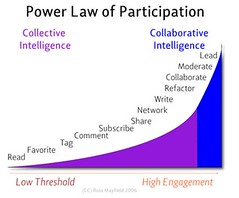
My dear friend Yaniv Golan, CTO of Yedda, had given a brilliant presentation regarding Incentives In Online Social Communities a few weeks ago at The Marker COM.vention and since it’s unfortunately in Hebrew, I wanted to translate it, include some of my own additions, and share it with you.
Online community participation
Let’s start with the obvious question….Why?
Why do users comment? Why do they write blogs? Why do they upload pics to Flickr? Why do they send links to friends?
What are the motives behind user participation in social communities? Understanding why users participate can lead us to understand further how to engage users and increase their participation in online communities. Let’s first learn a bit more about our users.
Membership life cycle for online communities

Amy Jo Kim was the first to propose the idea of a member’s life cycle in an online community (2000). The cycle suggests five phases of a user’s lifecycle within a community:
- Peripheral (i.e. Lurker) – An outsider, unstructured participation
- Inbound (i.e. Novice) – New user, invested in the community, on his way to full participation
- Insider (i.e. Regular) – Committed participator, member of the community
- Boundary (i.e. Leader) – A member brokering interactions and encouraging/sustaining participation
- Outbound (i.e. Elder) – On his way to leaving the community, perhaps to another community due to a particular change in the community or personal choice
Power Law of Participation
 According to Ross Mayfield:
According to Ross Mayfield:
“The vast majority of users will not have a high level of engagement with a given group, and most tend to be free riders upon community value. But patterns have emerged where low threshold participation amounts to collective intelligence and high engagement provides a different form of collaborative intelligence……
Digg is the archetype for low threshold participation. Simply Favorite something you find of interest, a one click action. You don’t even have to log in to contribute value, you have Permission to Participate. Del.icio.us taps both personal and social incentives for participation through the low threshold activity of tagging. Remembering the URL is the hardest part, and you have to establish an identity in the system. Commenting requires such identity for sake of spam these days and is an under-developed area. Subscribing requires a commitment of sustained attention which greatly surpasses reading alone. Sharing is the principal activity in these communities, but much of it occurs out of band (email still lives). We Network not only to connect, but leverage the social network as a filter to fend off information overload. Some of us Write, as in blog, and some of us even have conversations. But these are all activities that can remain peripheral to community. To Refactor, Collaborate, Moderate and Lead requires a different level of engagement — which makes up the core of a community…..Participation in communities plots along a power law with a solid core/periphery model — provided social software supports both low threshold participation and high engagement.”
All users activities in online communities whether low threshold or high engagement activities co-exist within a community to create a form of collective intelligence. Therefore it is key for virtual communities to allow both low threshold and high engagement participation so that users in all 5 phases of their lifecycles will be made to feel comfortable within the community.
Participation Inequality
 Social Platforms – the 1% rule
Social Platforms – the 1% rule
- 90% of users are lurkers
- 9% of users contribute sometimes
- 1% of users actively participate and are responsible for almost all the action
On Wikipedia for example, participation inequality is even higher. More than 99% of Wikipedia’s users are lurkers. Only 0.2% are active participants. Wikipedia’s most active 1,000 people — 0.003% of its users — contribute about two-thirds of the site’s edits.
We see here that small groups of people often turn out to be the main value creators of social communities. Over time, their actions fuel widespread interaction that engages the lurkers and attracts new users. If continually nurtured, the community can become a self-sustaining generator of content and value.
So let’s go back now to our initial question:
Why do users participate in virtual communities?
According to Peter Kollock in The Economies of Online Cooperation: Gifts and Public Goods in Cyberspace, there are three major reasons for why users contribute in online communities:
- Anticipated Reciprocity – A user is motivated to contribute to the community in the expectation that he will receive useful help and information in return. Indeed we have seen such active users receiving more help than lurkers.
- Increased recognition – individuals want recognition for their contributions. the desire for prestige is one of the key motivations for individuals’ contributions in an online community. Contributions will likely increase if they are visible to the whole community and are credited to the contributor. … the powerful effects of seemingly trivial markers of recognition (e.g. stars, ranking) are overwhelming.
- Sense of efficacy – Individuals may contribute because the act results in a sense that they have had some effect on the community. Wikipedia is a good example of this.
 Yet there are also other elements which can motivate users to become active in online communities:
Yet there are also other elements which can motivate users to become active in online communities:
- Connections within the community – the more friends a user has within a given community, the more important it becomes for him to participate in. Therefore it’s important for online communities to allow users to form friendships easily and encourage a high level of interaction between users.
- Emotional Safety – a sense of belonging and identifying with the community. Once users become regulars in a community, just like in any offline community, they stop feeling fearful and begin to feel a sense of safety in and identification with the community. The key here is to get these individuals to become regular users in your community and create a cozy and ”feel good” environment for them.
- Common emotional connection – niche communities that are built around a particular emotional connection/cause between members tend to become more cohesive and experience lower percentages of participation inequality.
- Altruism – Yossi Vardi coined the term “Dopamine Over IP” – each user transfers dopamine to another user….by contributing content, a user knows that he will cause pleasure to those who view it and those users that forward this content onwards, know the same.
For more reasons why people become active participants in social online communities and the key to Web 2.0’s success, please see my posts:
So now you ask…
What are the ways that online communities can overcome participation inequality and increase users’ participation?
- Make it easy for users to contribute, make them feel confident with their contributions, and share their contributions with other members in the community -> Feeling of influence
- Make participation a side effect. Let users participate with zero effort by making their contributions a side effect of something else they’re doing. For example, Amazon’s “people who bought this book, bought these other books” recommendations are a side effect of people buying books. You don’t have to do anything special to have your book preferences entered into the system.
- Reward users’ contributions and allow for markers of their contributions. Promote and feature top contributors -> Sense of recognition, sense of community, fulfill anticipated reciprocation
- Platform should be flexible enough to transform with the changing needs of its members -> feeling of influence
- According to virtual community pioneer Jonathan Bishop, online community managers need to also change the beliefs of lurkers on their site in order to increase participation. Lurkers, believe that they do not need to post messages or that they are being helpful by not posting. Such beliefs prevent them from carrying out their desires to be social and participate in the community. Therefore it is up to the community managers to change this attitude by use of persuasive text or by other means.
Allow users to rank each other within the community and comment on contributions -> sense of community, feeling of influence
A few more useful tips for community managers
- Simplicity is key – participating in the community should be simple for the user. The simpler it is, the higher the participation rate will be.
- Allow some actions to be performed by non-registered users.
- Give people something good to talk about – as always, content is king. If your content is interesting and appealing enough, people will be eager to contribute.
- Display the activity on your site. No one likes to go into an empty restaurant. Already on the homepage show users all the great stuff that’s happening within the community.
- Offline events are a great way to make a community even more cohesive and virtually active.
Get the TNW newsletter
Get the most important tech news in your inbox each week.





